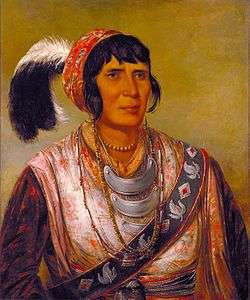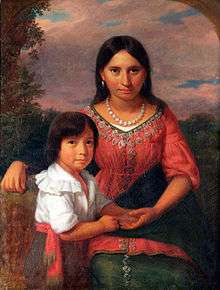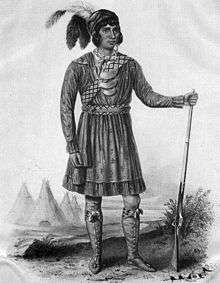Osceola
| Osceola | |
|---|---|
| Asi-yahola | |
 Osceola by George Catlin | |
| Seminole leader | |
| Personal details | |
| Born |
1804 Talisi, Mississippi Territory, US |
| Died |
30 January 1838 (aged 33–34) Fort Moultrie, South Carolina, US |
| Cause of death | Quinsy or malaria |
| Resting place | Fort Moultrie, South Carolina, US |
| Children | at least 5 |
| Parents | Molly Coppinger & William Powell |
| Nickname(s) | Billy Powell |
Osceola (1804 – January 30, 1838, Asi-yahola in Creek), named Billy Powell at birth in Alabama, became an influential leader of the Seminole people in Florida. Of mixed parentage, including Creek, Scottish, African American, and English, he was considered born to his mother's people in the Creek matrilineal kinship system. He was reared by her in the Creek tradition. When he was a child, they migrated to Florida with other Red Stick refugees after their group's defeat in 1814 in the Creek Wars. There they became part of what was known as the Seminole people.
In 1836, Osceola led a small group of warriors in the Seminole resistance during the Second Seminole War, when the United States tried to remove the tribe from their lands in Florida to Indian Territory west of the Mississippi River. He became an adviser to Micanopy, the principal chief of the Seminole from 1825 to 1849.[1] Osceola led the Seminole resistance to removal until he was captured on October 21, 1837, by deception, under a flag of truce,[2] when he went to a site near Fort Peyton for peace talks.[3] The United States first imprisoned him at Fort Marion in St. Augustine, then transported him to Fort Moultrie in Charleston, South Carolina. He died there a few months later of causes reported as an internal infection or malaria. Because of his renown, Osceola attracted visitors in prison, including renowned artist George Catlin, who painted perhaps the most well-known portrait of the Seminole leader.[4][5]
Early life
Osceola was named Billy Powell at birth in 1804 in the Creek village of Talisi, now known as Tallassee, Alabama, in current Elmore County. The inhabitants of the town of Tallassee were an admixture of Native American, English, Irish, and Scottish ethnicity, while some were African-American blacks. The Creek were among the Southeastern Native Americans who held slaves. Powell was believed to have ancestors from all of these groups.[6] His mother was Polly Coppinger, a mixed-race Creek woman, and his father was most likely William Powell, a Scottish trader.[7]
Polly was also of Creek and European ancestry, as the daughter of Ann McQueen and Jose Coppinger. Because the Creek had a matrilineal kinship system, Polly and Ann's children were all considered to be born into their mother's clan; they were reared by their mothers and their maternal male relatives as traditional Creek and gained their social status from their mother's people. Ann McQueen was also mixed-race Creek; her father, James McQueen, was Scottish. Ann was probably the sister or aunt of Peter McQueen, a prominent Creek leader and warrior. Like his mother, Billy Powell was raised in the Creek tribe.[8]
Billy Powell's maternal grandfather, James McQueen, was a ship-jumping Scottish sailor who in 1716 became the first recorded white to trade with the Creek tribe in Alabama. He stayed in the area as a fur trader and married into the Creek tribe, becoming closely involved with this people. He was buried in 1811 at the Indian cemetery in Franklin, Alabama, near a Methodist Missionary Church for the Creek.[9]
In 1814, after the Red Stick Creek were defeated by United States forces, Polly took Osceola and moved with other Creek refugees from Alabama to Florida, where they joined the Seminole. In adulthood, as part of the Seminole, Powell was given his name Osceola (/ˌɒsiːˈoʊlə/ or /ˌoʊseɪˈoʊlə/). This is an anglicized form of the Creek Asi-yahola (pronounced [asːi jahoːla]); the combination of asi, the ceremonial black drink made from the yaupon holly, and yahola, meaning "shout" or "shouter".[10]
In 1821, the United States acquired Florida from Spain, and more European-American settlers started moving in, encroaching on the Seminoles' territory. After early military skirmishes and the signing of the 1823 Treaty of Moultrie Creek, by which the US seized the northern Seminole lands, Osceola and his family moved with the Seminole deeper into the unpopulated wilds of central and southern Florida.[11]
As an adult, Osceola took two wives, as did some other high-ranking Creek and Seminole leaders. With them, he had at least five children. One of his wives was African American, and Osceola fiercely opposed the enslavement of free people.[12]
1830s resistance and war leader
Through the 1820s and the turn of the decade, American settlers kept up pressure on the US government to remove the Seminole from Florida to make way for their desired agricultural development. In 1832, a few Seminole chiefs signed the Treaty of Payne's Landing, by which they agreed to give up their Florida lands in exchange for lands west of the Mississippi River in Indian Territory. According to legend, Osceola stabbed the treaty with his knife, although there are no contemporary reports of this.[13] Donald L. Fixico, an American Indian historian, says he made a research trip to the National Archives to see the original Treaty of Fort Gibson (also known as the Treaty of Payne's Landing), and that upon close inspection, he observed that it had "a small triangular hole shaped like the point of a knife blade". [14]
Five of the most important Seminole chiefs, including Micanopy of the Alachua Seminole, did not agree to removal. In retaliation, the US Indian agent, Wiley Thompson, declared that those chiefs were deposed from their positions. As US relations with the Seminole deteriorated, Thompson forbade the sale of guns and ammunition to them. Osceola, a young warrior rising to prominence, resented this ban. He felt it equated the Seminole with slaves, who were forbidden by law to carry arms.[15]
Thompson considered Osceola to be a friend and gave him a rifle. Osceola had a habit of barging into Thompson's office and shouting complaints at him. On one occasion Osceola quarreled with Thompson, who had the warrior locked up at Fort King for two nights until he agreed to be more respectful. In order to secure his release, Osceola agreed to sign the Treaty of Payne's Landing and to bring his followers into the fort. After his humiliating imprisonment, Osceola secretly prepared vengeance against Thompson.[16]
On December 28, 1835, Osceola, with the same rifle Thompson gave him, killed the Indian agent. Osceola and his followers shot six others outside Fort King, while another group of Seminole ambushed and killed a column of US Army, more than 100 troops, who were marching from Fort Brooke to Fort King. Americans called this event the Dade Massacre. These nearly simultaneous attacks catalyzed the Second Seminole War with the United States.[17][18]
Capture

On October 21, 1837, Osceola and 81 of his followers were captured by General Joseph Hernández on the orders of General Thomas Jesup, under a white flag of truce, when they went for peace talks to Fort Peyton near St. Augustine.[19][20][21] He was initially imprisoned at Fort Marion in St. Augustine, before being transferred to Fort Moultrie on Sullivans Island, outside Charleston, South Carolina. Osceola's capture by deceit caused a national uproar. General Jesup's treacherous act and the administration were condemned by many congressional leaders and vilified by international press. Jesup suffered a loss of reputation that lasted for the rest of his life; his betrayal of the truce flag has been described as "one of the most disgraceful acts in American military history."[22]
That December, Osceola and other Seminole prisoners were moved to Fort Moultrie in Charleston, South Carolina. They were visited by various townspeople.[23] The portraitists George Catlin, W. M. Laning, and Robert John Curtis, the three artists known to have painted Osceola from life, persuaded the Seminole leader to allow his portrait to be painted despite his being gravely ill.[24][25] Osceola and Curtis developed a close friendship, conversing at length during the painting sessions; Curtis painted two oil portraits of Osceola, one of which remains in the Charleston Museum.[26] These paintings have inspired numerous widely distributed prints and engravings, and cigar store figures were also based on them.
Osceola, having suffered from chronic malaria since 1836, and having acute tonsillitis as well, developed an abscess[27] and died of quinsy[28] on January 30, 1838, three months after his capture.[29][30] He was buried with military honors at Fort Moultrie.
Legacy and honors
Template:See also Osceola
- Numerous landmarks, including Osceola counties in Florida, Iowa, and Michigan, were named after him.
- Florida's Osceola National Forest was named for him.
- Mount Osceola, located in the White Mountain National Forest of New Hampshire.
- Lake Osceola, a lake located on the campus University of Miami.
- Battery Osceola at Fort Taylor, Key West, Florida is named after him.[31]
- Several colleges and universities, among them Florida State University and the University of Central Florida, have buildings named for Osceola.
- Ocilla, a small town in South Georgia, was named after him.
Descendants

- Chief Joe Dan Osceola, Ambassador of the Seminole Tribe, is Osceola's great-great-great grandson.
Relics
After Osceola's death, army doctor Frederick Weedon persuaded the Seminole to allow him to make a death mask of Osceola. This was a European-American custom at the time for prominent people. Later he removed Osceola's head and embalmed it. For some time, Weedon kept the head and a number of personal objects which Osceola had given him.[32] Later, Weedon gave the head to his son-in-law Daniel Whitehurst. In 1843, Whitehurst sent the head to Valentine Mott, a New York physician. Mott placed it in his collection at the Surgical and Pathological Museum. It was presumably lost when a fire destroyed the museum in 1866.[32] Some of Osceola's belongings are still held by the Weedon family, while others have disappeared.
Captain Pitcairn Morrison sent the death mask and some other objects collected by Weedon to an army officer in Washington. By 1885, the death mask and some of Osceola's belongings were being held in the anthropology collection of the Smithsonian Institution. The death mask is currently housed in the Luce collection of the New-York Historical Society. [33]
In 1966, Miami businessman Otis W. Shriver claimed he had dug up Osceola's grave and put his bones into a bank vault to rebury them at a tourist site at the Rainbow Springs. Shriver traveled around the state in 1967 to gather support for his project. Archaeologists later proved that Shriver had dug up animal remains; Osceola's body was still in its coffin.
In 1979 the Seminole Nation of Oklahoma bought Osceola's bandolier and other personal items from a Sotheby's auction. Because of the chief's significance, over time some people have created forgeries of Osceola's belongings. Rumors persist that his embalmed head has been found in various locations.
_Florida_-_OSEOLA_(Osceola).jpg)

Related media
- Literature related to Osceola*
- Osceola (1858) by Thomas Mayne Reid.
- In the Wilds of Florida: A Tale of Warfare and Hunting (1880) by William Henry G. Kingston.
- Freedom Land: A Novel by Martin L. Marcus. In this version, Osceola was the son of a respected British officer and his Creek consort.
- War Chief of the Seminoles (1954), a children's book by May McNeer, is part of the Landmark Books series.
- "A People's History of the United States" (1980) by Howard Zinn
- Osceola/ His Capture and Seminole Legends (2010), non-fiction by William Ryan.
Fiction and poetry
- "Osceola" (1889) is a poem by Walt Whitman, featured in Leaves of Grass.[34]
- Osceola, Häuptling der Seminole-Indianer (1963) by Ernie Hearting, is a German novel featuring Osceola and based on historical sources.
- Tourist Season and Nature Girl, mystery novels by Carl Hiaasen, each give an abbreviated history of Osceola's capture and imprisonment, as well as that of his contemporary, Thlocklo Tustenuggee.
- Light a Distant Fire (1988) by Lucia St. Clair Robson
- Captive (1996), a historical novel by Heather Graham, features Osceola as one of the protagonists.
- Osceola "Ossie" Bigtree is the name of a character in Karen Russell's novel Swamplandia!, about a family of alligator wrestlers who work at a tourist attraction in Florida. It was developed from her short story "Ava Wrestles the Alligator".
- In the alternate history novel The Probability Broach , part of the North American Confederacy Series by L. Neil Smith, the United States becomes a Libertarian State after a successful Whiskey Rebellion and execution of George Washington. The figure of Osceola is featured as the ninth President of the North American Confederacy, serving from 1842 to 1848.
- Osceola was an early pen name used by Danish author, Karen Blixen, known primarily for her novels and stories set in Kenya during the colonial period. She also published as Isak Dinesen.[35]
- Film related to Osceola
- In the mid-1930s Nathanael West wrote a 17-page film treatment entitled Osceola, but failed to sell it to a studio.
- Seminole (1953), highly fictionalized American western film directed by Budd Boetticher and starring Anthony Quinn as Osceola.
- Naked in the Sun (1957), the life of Osceola and the Second Seminole War, starring James Craig as Osceola.
- Osceola – Die rechte Hand der Vergeltung (1971) by Konrad Petzold, an East German western with Gojko Mitić as the Native American leader.
- Television, music, sports, and art related to Osceola
- 1957 Jim Bowie TV-series episode "Osceola". When the army attempts to remove the Seminole Indians from their own lands to a less desirable tract, Bowie steps in on their behalf.
- The song "Seminole Wind", the title track of the album by the same name by John Anderson, refers to hearing the ghost of Osceola. The song has been covered by James Taylor and Gravemist.
- Osceola and Renegade are mascots of the Florida State Seminoles football team. The use of Osceola and Renegade as a symbol was approved by the Seminole Tribe of Florida.[36]
- The Sedgeford Hall Portrait, once thought to be of Pocanontas and her mixed-race son, Thomas Rolfe, is now believed to be of Pe-o-ka (a wife of Osceola) and their son.[37]
References
- ↑ "Osceola, the Man and the Myths", retrieved January 11, 2007 Archived December 2, 2006, at the Wayback Machine.
- ↑ Mahon, John K. (1985) History of the Second Seminole War, 1835–1842, 2nd ed. Gainesville: University of Florida. ISBN 0813010977. p. 214: "General Jessup now reached the decision which was to make him more infamous than famous in the eyes of many generations. He decided to persist in his new policy of ignoring flags of truce."
- ↑ Patricia Riles Wickman (27 August 2006). Osceola's Legacy. University of Alabama Press. p. 135. ISBN 978-0-8173-5332-2.
- ↑ Mahon 1985, pp. 217–218
- ↑ Wickman 2006, pp. 115–116
- ↑ Phyllis Shapiro (2000). "Myths and Dreams: Exploring the Cultural Legacies of Florida and the Caribbean". kislakfoundation.org. Miami, Florida: Jay I. Kislak Foundation. Archived from the original on August 4, 2017. Retrieved 4 May 2018.
The people in the town of Tallassee, where Billy Powell, (later named Osceola) was born, were mixed-blood Native American/English/Irish/Scottish, and some were black. Billy was all of these.
- ↑ Spencer Tucker (2013). Almanac of American Military History. ABC-CLIO. p. 620. ISBN 978-1-59884-530-3.
- ↑ Thom Hatch (17 July 2012). Osceola and the Great Seminole War: A Struggle for Justice and Freedom. St. Martin's Press. p. 19. ISBN 978-0-312-35591-3.
- ↑ Hatch 2012, p. 8
- ↑ Bright, William (2004) Native American Placenames of the United States, University of Oklahoma Press. p. 185 ISBN 978-0-8061-3598-4
- ↑ Hatch 2012, pp. 55–58
- ↑ Giddings, Joshua R. (1858). The Exiles of Florida. Columbus, OH: Follet, Foster and Company. p. 97.
- ↑ Hatch 2012, pp. 87–89
- ↑ Donald L. Fixico (12 October 2017). "That's What They Used to Say": Reflections on American Indian Oral Traditions. University of Oklahoma Press. p. 79. ISBN 978-0-8061-5928-7.
- ↑ Hatch 2012, pp. 82–85
- ↑ Hatch 2012, p. 90
- ↑ Mishall, John and Mary Lou Mishall. 2004. The Seminole Wars: America's Longest Indian Conflict. University Press of Florida. ISBN 0-8130-2715-2. pp. 90–91, 95–97.
- ↑ Hatch 2012, pp. 102–108
- ↑ United States. Congress. House. House Documents, Otherwise Publ. as Executive Documents: 13th Congress, 2d Session-49th Congress, 1st Session. p. 6.
- ↑ Patricia Riles Wickman (27 August 2006). Osceola's Legacy. University of Alabama Press. p. 25. ISBN 978-0-8173-5332-2.
- ↑ Edward J. Reilly (25 June 2011). Legends of American Indian Resistance. ABC-CLIO. p. 104. ISBN 978-0-313-35209-6.
- ↑ Hatch 2012, pp. 221, 218
- ↑ Hatch 2012, pp. 213–215
- ↑ Mahon 1985, pp. 217–218
- ↑ Wickman 2006, pp. 115–116
- ↑ Hatch 2012, p. 231
- ↑ Hatch 2012, p. 233
- ↑ Patricia Riles Wickman (27 August 2006). Osceola's Legacy. University of Alabama Press. p. 144. ISBN 978-0-8173-5332-2.
- ↑ Shapiro 2000
- ↑ Christopher G. Bates (8 April 2015). The Early Republic and Antebellum America: An Encyclopedia of Social, Political, Cultural, and Economic History. Routledge. p. 777. ISBN 978-1-317-45740-4.
- ↑ Fort Taylor, Key West at FortWiki.com
- 1 2 Milanich, Jerald T. (January/February 2004) "Osceola's Head", Archaeology
- ↑ "Seminole Chief Osceola (1804-1838)". www.nyhistory.org. New-York Historical Society. Archived from the original on June 3, 2016. Retrieved 3 May 2018.
- ↑ Whitman, Walt (1889 or 1890) Osceola. whitmanarchive.org
- ↑ "Isak Dinesen". Penguin Classics Authors. Penguin Classics. Retrieved 2012-01-05.
- ↑ Wieberg, Steve (August 23, 2005). "NCAA allowing Florida State to use its Seminole mascot". USA Today. Retrieved October 11, 2011.
- ↑ Navab, Valorie. American Indian Summer 2013, Smithsonian Institution.
External links
| Wikimedia Commons has media related to Osceola. |


- Osceola at Find a Grave